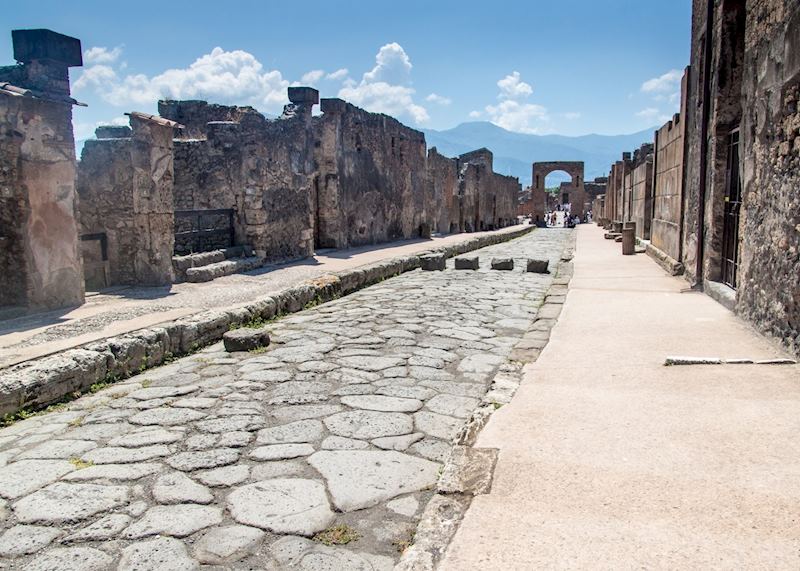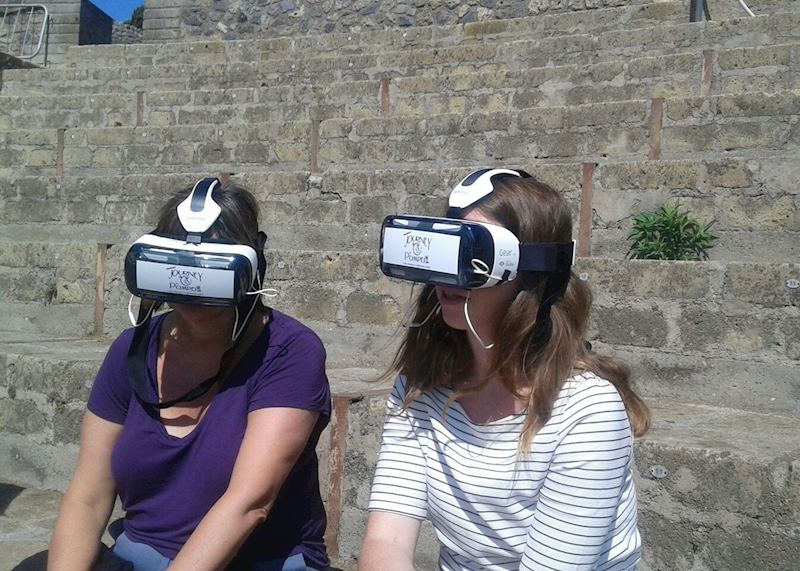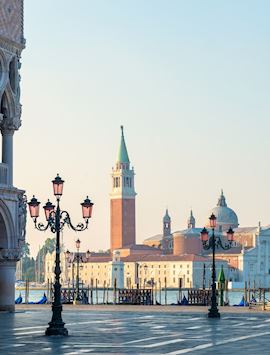By Italy specialist Claire
An ancient Italian tribe who grew in power due to their civil and military prowess, the Romans have had an indelible impact on Italy’s — and Europe’s — history and culture. To list all their feats, from literature to the legal system, is beyond the scope of this article, but modern day Italy is visibly saturated in their legacy. Walking around central Rome, you’ll find impressive Roman achievements in engineering, construction, art and architecture around every corner.
Consider the fact that Rome’s Pantheon (completed in 128 AD) remains to this day the largest unsupported dome in the world, or that Rome’s Trevi Fountain is still fed by an ancient 20 km (12.4 mile) long Roman aqueduct buried underneath the city streets.
The best way to make sense of the most famous Roman sites, mostly clustered in the capital, is to visit with a private guide who can provide you with some tailored historical context. However, at some sites, including mammoth Pompeii in southern Italy, technological innovations are now being used to enhance and animate visitors’ experiences.
Roman sites to see in Rome
Explore the battleground of gladiators at the Colosseum

This immense elliptical arena rises up magisterially in southern central Rome. Some two thousand years since it was built, half of the Colosseum’s outer wall remains standing (the missing half was plundered during the Renaissance). Its vast layered arcades of Doric, Ionic and Corinthian columns were clad in travertine stone, with each alcove filled by a statue. Linen awnings, attached to a series of poles on the upper arcade, would shield the crowds from sun or rain.
Guides are crucial here for two reasons. They know how to avoid lengthy wait times (you’ll see ticket vendors offering ‘jump the line’ passes, but in reality these can lead to longer waits). Then, once inside, the sheer scale and the multilayered nature of this ruin can be overwhelming. Private guides can help you structure what you’re seeing, and they know the routes to take to avoid the big tour groups.
The brainchild of the emperor Vespasian, the Colosseum was inaugurated in 80 AD and was used to entertain both the masses and the social elite through the staging of bloody battles between gladiators and wild animals. When I last visited, my guide was particularly good at painting a detailed picture of how these spectacles would have played out.
At one point, she led us through a grand archway, the entrance reserved for the emperor. She pointed out where the richest Romans would have sat (the tier closest to the action), and where ordinary citizens could buy food and wine from stands set up around the arena.
Perhaps the most impressive sight in the Colosseum is the underground warren of passages and holding pens for the gladiators and exotic animals such as lions and tigers. It’s now almost fully exposed as the original arena floor has gone. Animals’ cages could be winched up to just below the floor, then they would be released into the arena through trap doors.
Part of the arena floor has been reconstructed over the pens. It would have been covered in sand — ‘arena’ is, in fact, derived from the Latin word for sand — to absorb blood.
If you’re visiting Verona, near Venice in northwest Italy, make sure to see its smaller but much more intact Roman arena. There’ll be fewer crowds and its acoustics are particularly effective: today, operas are performed here.
Find the Roman Forum’s hidden corners

Think of the Forum, across the road from the Colosseum, as ancient Rome’s central business district, the Roman Empire’s Midtown Manhattan. It was a conglomeration of civic, political and commercial buildings but also temples.
I’ll be honest: at first sight, the Forum can seem like a bewildering open-air mishmash of shells of buildings, arches and rows of columns missing the buildings they once fronted. My main piece of advice is to go with a guide who’ll take you through one of the Forum’s quieter, little-used side entrances (most visitors tend to enter on Capitoline Hill). They’ll help you reconstruct these ruins and explain the function of each one.
There’s a huge amount to see here, such as the remains of the basilicas, or law courts, where Roman lawyers would pay spectators to jeer or applaud as necessary at trials (‘basilica’ in this context had no religious connotation). Then there are temples, triumphal arches, and rostrums where public speeches were made.
Your guide will take you along the avenues and paths that are less trodden, and show you details, such as rose gardens where plants have flowered since Roman times, and the remains of the temple where Julius Caesar’s cremated remains were laid. Up on pine-wooded Palatine Hill, overlooking the Forum, you can walk among the grand skeletons of imperial palaces and their private gardens.
Admire the Pantheon

The Pantheon — meaning a temple to all the gods — stands in a piazza in the hub of central Rome. Its scale isn’t apparent until you’re standing directly in front of it. Its 43.3 m (142 ft) dome is flanked by a columned portico whose Latin inscription explains that it was first built by the emperor Marcus Agrippa in 27 to 25 BC. In 603 AD, the Pantheon was consecrated as a Christian church. Today, it’s the best preserved and most intact of all Roman structures in existence.
The bronze doors under the large portico open to reveal a cavern-like interior under the dome’s coffered ceiling. Renaissance artists would study the seemingly impossible geometry and construction of this freestanding dome. Brunelleschi was allegedly inspired by it to create the gargantuan dome of Florence’s Duomo.
The building’s only light source is an oculus — a circular opening — right in the dome’s apex. If you visit while it’s raining, you’ll witness another marvel originating from Roman engineering: the water is carried away into the drainage system built into the floor.
Although you can visit the Pantheon with a guide on a walking tour of Rome, it’s one of those sites that you’re likely to come across while you’re looking for another: the grandiose Trevi Fountain is only a few streets away, while Bernini’s playful elephant and obelisk sculpture lies around the corner in Piazza della Minerva. For me, this is part of the Pantheon’s appeal — it’s at the heart of things, so it’s easy to pop in and admire its ingenious architecture.
Lesser-known Roman sites to visit in Rome

If you follow the steps leading down beneath the Palazzo Valentini, a Renaissance structure housing government offices that’s just north of the Forum, you’ll come to a series of underground chambers.
Standing on glass floors in each room, you look down onto the excavated remains of a Roman aristocrat’s house. Only discovered in 2005 when a parking lot was being built, the house’s rooms have been virtually reconstructed using sound and lighting.
You enter each room in succession as an audio commentary in English plays. At first, you’re in darkness, unable to see your surroundings. Then, as the audio guide explains what the room originally contained or was used for, light projections illuminate different features.
Half-ruined mosaics are ‘finished off’ using projections, so you can immediately see how richly this home was decorated. In another room, the ruins of a well and irrigation system are reanimated with a projection of running water.
Side showrooms display all the objects found at the site, such as pottery and helmets, but many items have been left in the rooms where they were found.
All in all, it’s a quirky, well executed and vivid way of exploring a more intimate, domestic Roman site.
See a secret Roman temple at San Clemente Basilica

This church demonstrates brilliantly how modern-day Rome has gradually been built over Roman foundations. San Clemente Basilica, located a few streets away from the Colosseum, dates from the 12th century and overlays an earlier 4th century church. Walking through the sacristy leads to the even older remains of a Roman-era temple to Mithras.
It’s a stark, low-ceilinged stone room. Listen carefully, and you might be able to hear the sound of running water from a Roman-built aqueduct nearby. In the middle of the room, there’s a simple altar carved with a relief of the Persian-derived god Mithras slaying a bull.
The room itself wasn’t so much a temple as a place for ritual banquets. Mithraism was a mysterious, male-only cult that made use of initiation rites and it had an underground following in the Roman world. Today, little is known about it. Worshipers typically gathered in caves or underground chambers, out of public sight. It’s somehow fitting, then, that even in modern times this temple remains hidden from view.
Visit the ancient Roman Baths of Caracalla on a Vespa tour

A sprawling complex of crumbling red-brick towers and archways in southwest Rome, you’ll need to use your imagination to get a feel for what these thermae (public baths) originally looked like. A good guide will be able to explain all the different elements used in the Roman bathing ritual, from the circular, humid calidarium (hot steam room) to the natatio (open-air swimming pool).
The size of the baths really struck me: the site dwarfs some of the buildings in the Forum. It also contained a public library and gym (plus — interestingly — another hidden temple to Mithras).
The baths are set a little way out of central Rome, and a great way to see them is on a Vespa tour. En route, your driver will take you past many other Roman sites, from the Circus Maximus, where chariot races were held, to the cobbled vestiges of the Via Appia, one of the most strategically important Roman roads.
What to see at Pompeii

Smothered in 6 m (19.6 ft) of volcanic ash when nearby Mount Vesuvius erupted in 79 AD, this prosperous Roman town’s destruction was also the key to its protection from erosion. Buried for centuries under calcified ash, buildings and streets have been eerily well preserved down to details such as intricate mosaics.
Walking around its sunken, cobbled streets today, it’s a ghost town of abandoned villas, workshops, shops, markets, courthouses, public baths, an arena and temples. Even though excavations have been ongoing since the 18th century — longer than at any other site in the world — the eastern part of the town has yet to be fully unearthed.
To appreciate Pompeii fully, and for insights into how its inhabitants lived, first visit the National Archaeological Museum in Naples. Among its collections are the majority of the artifacts found at Pompeii. Some of the pieces — such as decorative glass jugs and silverware — are much more sophisticated than anything I could have imagined. Frescoes found in Pompeiian buildings have also been preserved here, including erotic art that scandalized the site’s first 18th-century excavators.


The museum also contains the emotive sight of body casts of some of the eruption’s victims. When Vesuvius blew, ash rained down on the city, covering the fallen and then hardening around bodies, leaving a void as they decomposed. When excavators filled the cavities with plaster, it captured an individual’s posture at the moment of death. The museum is the best place to see these casts, but there is a handful on display at Pompeii, including the cast of a writhing dog.
The main places of interest in Pompeii are best explored with a private guide. However, a more interactive and dynamic way of visiting Pompeii is through an augmented reality tour.
Accompanied by a technician and wearing 3D goggles, you’ll walk to different spots around the site and witness a cartoon-like augmented reality version of what you’re seeing. The remains of a shop with wine urns outside are transformed into a bustling street scene, with people buying food and going about their daily business. You can visit the steam baths, and even witness Vesuvius erupting with people running through the streets.
What to see at Herculaneum

Like Pompeii, this site was buried as a result of pyroclastic flows (avalanches of ash, pumice and rock) and mudslides after Vesuvius erupted in 79 AD. Much smaller than Pompeii, Herculaneum seems to have been a settlement for wealthy Roman nobles and a few craftsmen. Their villas were more elegant than those at Pompeii, and covered in multi-hued marble.
Many of the features of the houses, such as wooden doors and bedframes, have been preserved. I’d ask your guide to show you these finer details on a selection of buildings, as well as giving an overview of the whole site.
You can still see a lot of mosaics and frescoes in their original state in Herculaneum. I particularly like the Casa dei Cervi (House of the Deer), whose frescoes include images of stags and dogs.
Start planning your trip to Italy's key Roman sites
Start thinking about your experience. These itineraries are simply suggestions for how you could enjoy some of the same experiences as our specialists. They're just for inspiration, because your trip will be created around your particular tastes.
View All Tours in Italy



